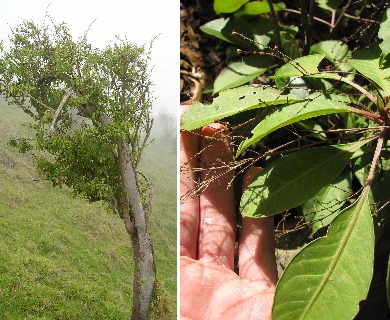Broadleaf Papala
Charpentiera obovata
Atriplex/Chenopodium family (Amaranthaceae)
Native species ()
native shrub or small tree with small to large oblong hairless leaves and distinctive showy but tiny stalkless flowers very numerous along wiry branches of very large drooping clusters. Shrub or small tree 15–30 ft (4.6–9.1 ) high and 4 inches (0. 1 ) to more than 2 ft (0.6 ) in trunk diameter, often becoming enlarged into buttresses at base. Bark gray or light brown, smooth. Inner bark orange brown streaked, bitter. Twigs slender, green to brownish green, hairless, with half round slightly raised leaf scars and end bud of tiny leaves.

©2006 Forest And Kim Starr
Flower clusters () single at leaf bases, very slender and drooping, 4–16 inches (10–40 ) long, with several wiry branches to 8 inches (20 ), purplish or reddish, flowers many, stalkless, less than 1⁄8 inch (3 ) long, elliptical, composed of three tiny five purplish and with elliptical and two spreading
are dry, elliptical (utricle), brown, about 1⁄16 inch (2 ) long, covered by three with two spreading Seed single, elliptical, tiny, shiny black.
Wood is very soft and fibrous, composed of many rings, exceedingly lightweight when dry, and “will burn like paper.” Heartwood is grayish yellow and sapwood lighter colored. Tends to “honeycomb” in air drying.
Hawaiians formerly used the wood for fireworks. These fireworks displays from papala sticks were well described a century ago, by Isabella Sinclair (1885) in her book of paintings, “Indigenous Flowers of the Hawaiians,” perhaps the first on Hawaii’s wildflowers. Her observation, quoted by Rock (1913), merits repetition:
“On the northwest side of Kauai, the coast is extremely precipitous, the cliffs rising abruptly from the sea to a height of 1000–2000 ft (305–610 ), and from these giddy heights the ingenious and beautiful pyrotechnic displays take place.
“On dark moonless; nights upon certain points of these awful precipices, where a stone would drop sheer into the sea, the operator takes his stand with a supply of papala sticks, and, lighting one, launches it into space. The buoyancy of the wood causes it to float in midair, rising or falling according to the force of the wind, sometimes darting far seaward, and again drifting towards the land. Firebrand follows firebrand, until, to the spectators (who enjoy the scene in canoes upon the ocean hundreds of feet below), the heavens appear ablaze with great shooting stars, rising and falling, crossing and recrossing each other, in the most weird manner. So the display continues until the firebrands are consumed, or a lull in the wind permits them to descend slowly and gracefully to the sea.”
This species occurs in wet and dry forests through the islands at 600–5700 ft (183–1737 ). Of largest size in dry areas.
Special areas
Waimea Arboretum, Volcanoes, Kipuka Puaulu
Range
Hawaiian Islands only
This has five species (one shrubby) in Hawaii and another in the Austral Islands (Sohmer 1972). It honors Jean G. F. de Charpentier (1786–1855), German-born Swiss geologist, conchologist, and botanist. The family has very few tree species, but many including amaranth garden weeds.




